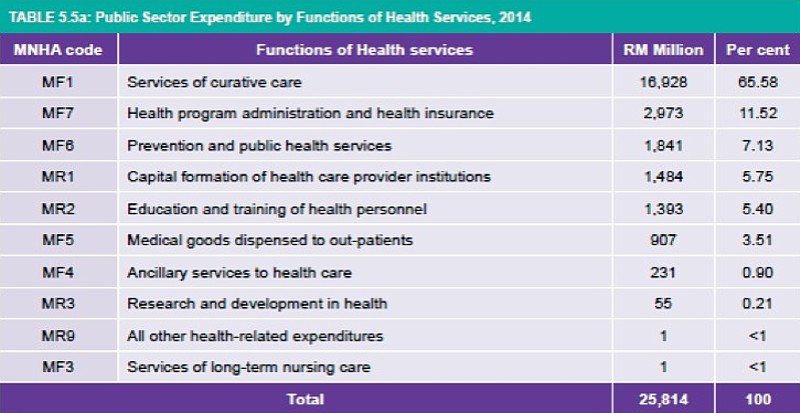Executive Summary
- There is a powerful moral, humanistic and economic case for preventive healthcare services, and it does not involve a zero-sum resource allocation game with curative services
- While there is no internationally accepted minimum standard, preventive healthcare in Malaysia is at risk of being underfunded
- We provide herein a basket of solutions to ring-fence the allocations for preventive healthcare services, to reduce barriers to access in the public and private sectors, and various incentives to encourage provision and take-up of preventive healthcare services
Introduction
The old adage “Prevention is better than cure” is founded not only on common-sense wisdom, but also on evidence from economics, health economics and policy. In this paper, we define the meaning of prevention, lay a case for why it is a public good, argue that Malaysia’s healthcare system is not allocating enough resources for prevention, and provide a set of workable recommendations to enhance the country’s preventive services in order to improve health and reduce unnecessary suffering for Malaysians.
Healthcare can be broadly divided into two categories: Curative and Preventive. The curative healthcare services are easily understood, and Malaysians do consult doctors and pharmacists, consume medicines, undergo surgeries and stay in hospitals whenever they need to cure a disease. Preventive healthcare is more invisible, and therefore perhaps less understood and less appreciated. It is divided into three categories: primary, secondary and tertiary prevention.
Primary prevention aims to prevent the disease itself, e.g. through vaccination or smoking cessation campaigns. Secondary prevention aims to detect diseases as early as possible, e.g. screening for cervical cancer or annual ECGs for those with hypertension. Tertiary prevention occurs when you already have the disease, and aims to reduce the disease’s severity, progression or complications, e.g. aggressive sugar control in diabetics to reduce the risk of kidney failure.
There is some overlap between tertiary prevention and the actual treatment of the disease; and therefore, this paper will only focus on primary and secondary prevention. While primary prevention can be implemented as a stand-alone activity, secondary prevention is closely linked to the curative part of the health services. Malaysia’s primary healthcare network is generally considered world-class, and enables a fairly rapid transition from population-based screening programmes to the actual treatment if a disease is found.
Preventive Healthcare as a Public Good
Preventive healthcare services are a clear public good, for three reasons. The first of these is humanistic. There are various moral and religious reasons for the prevention (not only the cure) of suffering,[1] all overlaid over the edifice of an individual human being’s inborn instinct for health, happiness and self-preservation. This humanistic good comes not only from a reduction of physical suffering, but also emotional and psychological suffering for patients and their family members.
Secondly, the scientific evidence is diverse and clear that preventive measures will help reduce healthcare costs. For example, every BCG vaccine is cost-effective,[2] protects against tuberculosis,[3] costs only a few ringgit [due to bulk purchase by Malaysia’s Ministry of Health (MOH)], and prevents tuberculosis, which requires RM3,780 per year to treat.[4] It is also reasonable common sense to assert that the absolute costs of preventive care is much lower than the absolute costs of curative care, e.g. a blood pressure screening programme is cheaper than building a hospital, or cost-saving.
Thirdly, preventive healthcare services are a clear public good because of the positive externalities of community preventive services in the general population. While curative services are usually individualised to one person’s disease, any investment in preventive health must necessarily cover as many people as possible, and will therefore have a nation-building component. An example of a positive externality is when vaccinations for polio only need to cover 80-85% of the population for herd immunity to kick in. Another example is the sense of societal or family cohesion that comes with a nationwide campaign for physical exercise or against smoking.
The humanistic and nation-building benefits of preventive healthcare are clear. We will extend the economic argument in three additional ways. Firstly, although we have a duty to appropriately control rising healthcare costs, money should not be the most important factor when the dignity of the human condition is under threat by disease. In other words, while there is a balance between the two extremes of going all-out to save a life and to save money, Malaysian society should be willing to pay quite high amounts to reduce human suffering.
Secondly, we must consider that some successful preventive healthcare measures may actually increase healthcare budgets in the short-run due to money invested in the measures themselves; and the increased diagnosis rates which then require (more expensive) curative services. However, this should be balanced out in the long-run by the cost-savings if there was late diagnosis or disease progression (to say nothing of the unquantifiable human cost of suffering).
Finally, we would like to introduce the concept of Health Capital.[5] This was first described in 1972 and states that “health can be viewed as a durable capital stock that produces an output of healthy time”. In economic terms, health can affect human beings in three distinct ways: direct well-being, productivity and longevity.[6] In more practical terms, if preventive healthcare can improve our health and reduce suffering, it can also increase our individual and national wealth through a healthier population, improved productivity and reduced absenteeism (i.e. time away from work due to disease) and presenteeism (i.e. going to work despite a disease, but performing poorly due to the disease). This is important to an average Malaysian (especially in the B40), because the costs of a disease are not just the direct cost of medicines and hospital stays, but also the indirect cost of skipping work for a daily wage-earner, the cost of family members caring for the sick person, and the cost of family members skipping work too.
It is crucial to restate that preventing diseases and suffering is a humanistic moral imperative for governments, purely on the basis of its medical benefits. Even on its own, better quality of life for Malaysians is persuasive enough to increase allocations for preventive healthcare. We are elaborating on the economic arguments for preventive care as an additional basis for our recommendations, and to prove that preventive healthcare makes powerful economic sense. We can even consider curative services to be consumption goods, and preventive services to be investment goods. Small wonder that even with the political polarisation in the US surrounding Obamacare, preventive healthcare services remain completely free for any insured person.[7]
Preventive Healthcare in Malaysia
In 2014 Malaysia spent a total of RM49.7bil for healthcare, averaging RM1,625/person.8 Of this RM49.7bil, 52% (RM25.8bil) was provided by the government from general taxation, and the remainder was provided by private households, insurers and companies. Of the RM25.8bil spent by the Malaysian government, 69% was spent on curative care and out-patient medical goods, and only 7% on prevention and public health services; in 1997, the equivalent percentages were 68% (for curative care and out-patient medical goods) and 5% (for preventive care).
Table 5.5a: Public Sector Expenditure by Functions of Health Services Malaysia (2014) [8]
There is no global standard on the right mix for curative/preventive services. As one comparison, the OECD31[9] average spending on preventive healthcare services is 2.8% and dropping,[10] which shows that Malaysia is above-average on at least two metrics. Other important metrics are the absolute dollar value of the allocation, the effectiveness of the measures, and presence of wastage and leakages. In a modelling study in Taiwan, the authors propose preventive healthcare spending at 0.0119% of GDP to maximise economic development and 0.0203% of GDP to maximise social welfare;[11] Malaysia’s percentage is 0.0022% of GDP, indicating that we can increase our preventive healthcare spending by up to 10 times.
Despite the widespread and politically popular rhetoric endorsing prevention, it remains true that prevention receives far less attention – and therefore funding – than curative services in Malaysia. It is also a political truism that countries with limited resources, a large national debt, or undergoing a recession will reduce government expenditure. Spending on preventive services is unglamorous and invisible to voters, and worse, wins no populist votes when compared to the grand opening of a clinic or hospital. Society and citizens will also understandably demand more spending in curative services because of the highly visible and immediate urgency of saving a life and curing a disease.
These reasons increase the risk that preventive services in Malaysia may be underfunded in the future.
List of Recommendations
We would like to provide the following recommendations following a basket-of-solutions approach for preventive healthcare services in Malaysia:
Ring-fencing and Increasing Allocations
- Ring-fencing a specific percentage of MOH annual healthcare spending to be devoted exclusively to preventive healthcare services for an indefinite number of years
- Increasing the percentage from 8% to 12% by 1% per year, starting with the 2019 National Budget, and ring-fencing these numbers in the annual planning process
- Revisiting the 12% allocation in 2023, using health economics and outcomes data, including cost-effectiveness and cost-utilisation analyses
- Hypothecating “sin taxes” – i.e. to allocate the collected taxes from tobacco, alcohol and gambling only to healthcare. This has the advantage of allowing citizens to visibly see that their taxes in these consumption activities are directly “reinvested” into healthcare, instead of going to a consolidated fund for general government spending
Reducing Barriers to Access
- Eliminating all user access fees (RM1 and RM5) for any citizen accessing preventive healthcare services in Malaysia
- Eliminating all cost-sharing arrangements in the public and private healthcare systems (i.e. no deductibles, co-pays or co-insurance in private sector insurance)
- Including preventive mental health measures in private insurance
Incentivising Provision and Take-up of Preventive Health Services
- Creating and delivering a “meta-education” campaign through a whole-of-government effort to educate all citizens about “Preventive Health as a Personal Investment”. The intention is to overcome the lack of psychological urgency in taking charge of one’s health when one is healthy, and to encourage self-reliance
- Providing tax incentives for SMEs and large corporations who institute preventive healthcare services for their workforce. An example is GSK’s Partnership for Prevention programme[12]
Conclusion
The case for adequate preventive healthcare services in Malaysia is a powerful moral, humanistic and economic one. We do not believe that there is any preventive/curative conflict in Malaysia’s healthcare resource allocation, and we believe that there should be no zero-sum game between the two. To truly live up to the wisdom of the old adage, Malaysia’s healthcare system must prevent preventive healthcare services from being neglected.
[1] Fitzpatrick SJ et al. (2016) Religious Perspectives on Human Suffering: Implications for Medicine and Bioethics. J Relig Health. Feb;55(1):159-173.
[2] Worldwide cost-effectiveness of infant BCG vaccination. (2006). Archives of Disease in Childhood, 91(8), 641.
[3] Roy, A et al (2014). Effect of BCG vaccination against Mycobacterium tuberculosis infection in children: systematic review and meta-analysis. BMJ. Aug 5;349.
[4] Ibrahim, E et al (2008). Cost of illness of tuberculosis in Penang, Malaysia. Pharmacy World & Science: 30. 281-6.
[5] Grossman, M (1972). On the Concept of Health Capital and the Demand for Health. Journal of Political Economy. Vol. 80, No. 2, 223-255.
[6] UNU-IHDP and UNEP. (2014). Inclusive Wealth Report 2014. Measuring progress toward sustainability. Summary for Decision-Makers. Delhi: UNU-IHDP.
[7] Preventive services ranked A or B by the USPSTF. https://www.healthcare.gov/coverage/preventive-care benefits/, accessed 22 Apr 2019.
[8] Ministry of Health Malaysia. (2016). Malaysia National Health Accounts: Health Expenditure Report 1997-2014. MOH Malaysia.
[9] OECD31 refers to all OECD countries except Hungary, Luxembourg and the Netherlands.
[10] Gmeinder M, et al (2017). OECD Health Working Paper No. 101 How Much Do OECD Countries Spend On Prevention?
[11] Wang F, et al (2016). Health expenditures spent for prevention, economic performance, and social welfare. Health Econ Rev. 2016 Dec; 6(1):45.
[12] Stepanek, M et al (2017). The return of investment for preventive healthcare programmes: A calculation framework for GSK’s Partnership for Prevention (P4P). Santa Monica, CA: RAND Corporation, 2017.
Managing Editor:Ooi Kee Beng, Editorial Team: Regina Hoo, Braema Mathi, Alexander Fernandez and Nur Fitriah (designer)
You might also like:
![Reconnecting Accountability Chains to Reform State-Owned Enterprises (SOEs)]()
Reconnecting Accountability Chains to Reform State-Owned Enterprises (SOEs)
![Picking the Brains of GLC Heads: Policy Priorities for Penang in the Coming Decade]()
Picking the Brains of GLC Heads: Policy Priorities for Penang in the Coming Decade
![The Skills Gap Remains Penang’s Big Challenge]()
The Skills Gap Remains Penang’s Big Challenge
![Combating Scam Syndicates in Malaysia and Southeast Asia]()
Combating Scam Syndicates in Malaysia and Southeast Asia
![Social Media Usage among Penangites: A Tool of Benefit or Distraction?]()
Social Media Usage among Penangites: A Tool of Benefit or Distraction?







